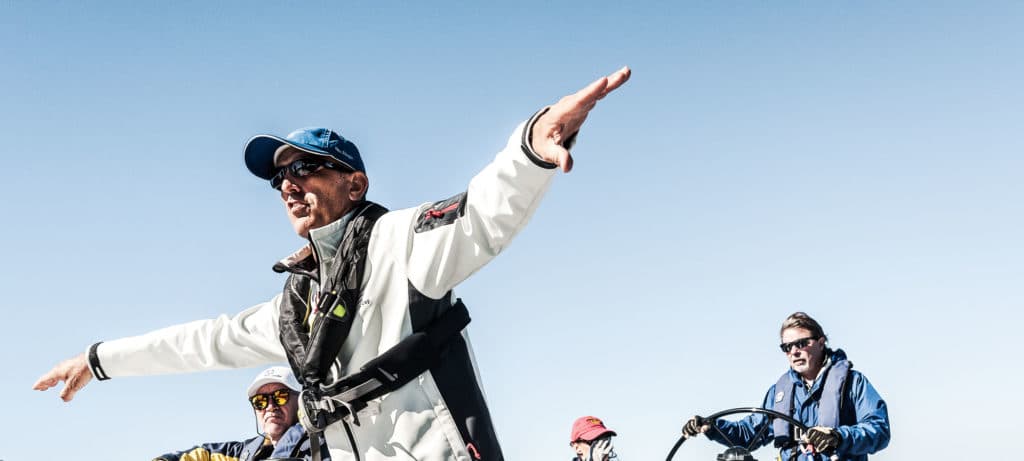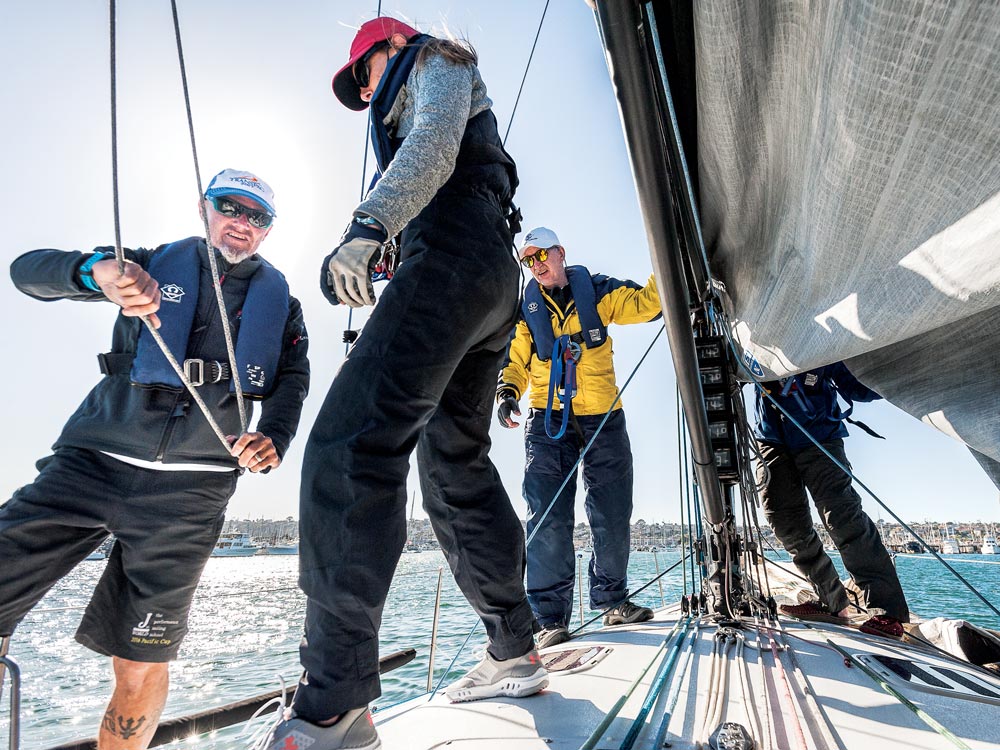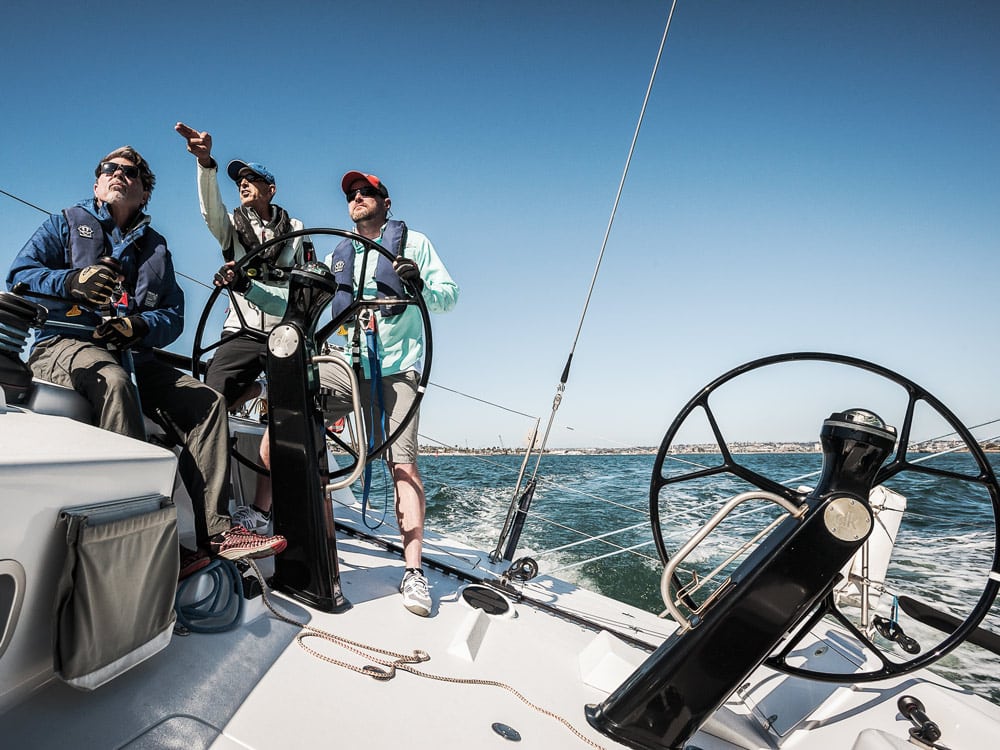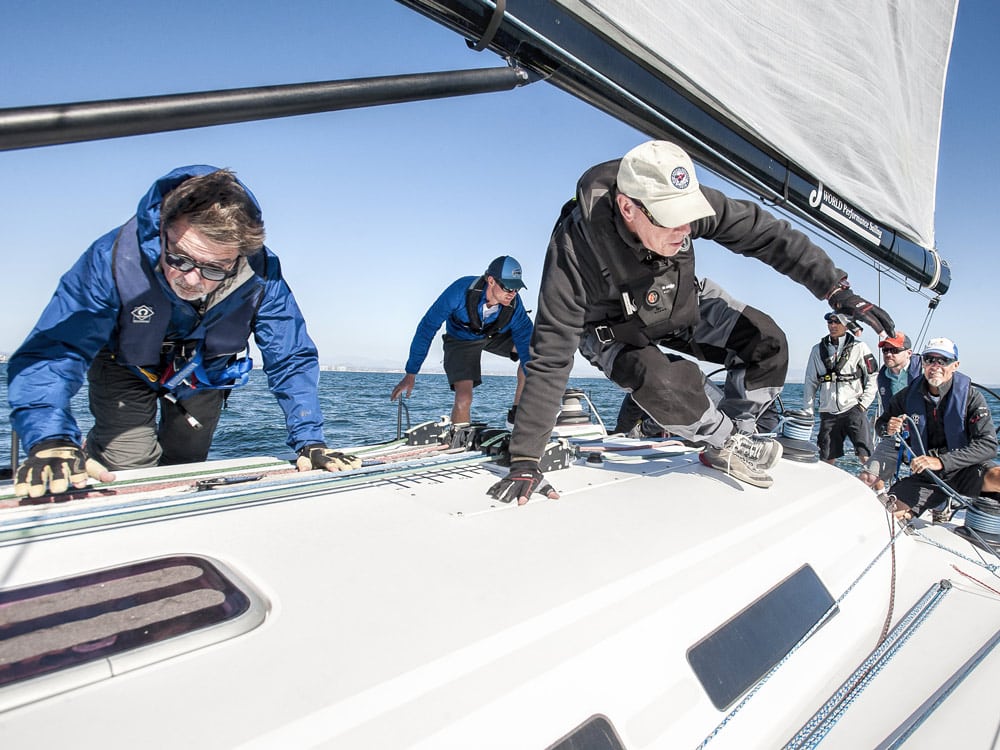
Wayne Zittel, a tall, lanky Southern Californian whose youthful demeanor belies his several decades as a professional sailor, describes the emotions most of his students experience through the early hours of the 1,000-mile San Diego to Puerto Vallarta Race.
“The first thing I tell them,” says Zittel, owner of J/World Performance Sailing School in San Diego, “is that 36 hours into the race, you’re going to climb into your berth, you’re going to be wet, you’re going to be cold and you’re probably going to be seasick.”
They’ll be thinking, This is the stupidest thing I’ve ever done.
Then comes Stage 2: wondering why they signed up in the first place. A strong desire to get off the boat comes next.
Then they start questioning why they’ve paid so much money for so much misery.
“But 48 hours later,” Zittel says, “they’ll have the spinnaker up and flying, the boat is level, and it’s suddenly the coolest thing they’ve ever done.”
Once they finish and suck down their first margarita, they can’t wait to do it again. Consider that Stage 3.
There are nine of us on board J/World’s custom 46-footer called Cazan, a grand-prix cruiser/racer weapon from the earlier days of IRC. We’re three days into the race, it’s Monday morning and we are catching our collective breath after the previous night’s wild ride. Zittel’s prophecy is true. The misery is gone, replaced by the ecstasy of swift and mesmerizing downwind sailing.
The breeze has built overnight, into the low 20s, and we’re surfing 5-foot swells under symmetric spinnaker and full main. The boatspeed numbers on our displays occasionally twitch higher into the midteens. Earlier, when the wind peaked a few knots higher, Zittel and our two other J/World coaches, Paul Martson and Patrick Farrell, took over the helm, standing watches. The full moon rose in the east, illuminating the Pacific ahead, as they kept the bow pointed into the illuminated runway, a white rocket careening through the night. Liftoff seemed a distinct possibility.
Below deck, I could feel every rudder movement, no matter how slight. The roar of white water tumbling against Cazan‘s topsides made conversation difficult. Sleep was nearly impossible. Windspeed was a sustained 20 knots until, around about 0400, a 29-knot gust filled the sails. With Martson at the helm, the digital readout jumped to 18.5 knots — a Cazan record. The on-watch crew erupted in cheers.

Now, in the waning morning light, the wind drops to what now seems a benign 25 knots. Fifteen over the bottom is the new norm. “How lucky we are,” comments crewmember Jim Lussier. “Not many people get to experience something like this.”
Lussier and I, along with Zittel, Martson, Farrell and four others, are sprinting past the Baja Peninsula, aiming for the mouth of the Sea of Cortez and eventually Banderas Bay before pulling into Puerto Vallarta, Mexico. For a boat like ours, it’s usually a five-day journey. Apart from the three coaches, there are six J/World clients.
“We usually get three types of people,” Zittel explained to me while we trained in San Diego. “Those for whom it’s an adventure — they’ve always dreamed of doing an offshore race to Hawaii or Mexico, and it’s on their bucket list.”
There’s also those who want to become more involved in offshore racing, but know they need more experience. Quite a few of Zittel’s clients have their own boats elsewhere in the United States. Although his operation is called J/World, there’s only a loose connection to its namesake, J Boats. Originally started to promote J/24 sailing, J/World spun off into a separate business that, on the West Coast, includes bases in San Francisco, San Diego and Puerto Vallarta. Although its reputation is primarily as a racing school, it runs learn-to-sail classes as well as basic cruising and bareboating.
It’s an entry point for people into the sport, Zittel says, but with the recently acquired DK46 and the Santa Cruz 50 Hula Girl (once campaigned by Hall of Famer Paul Cayard) in J/World’s stable, racing continues to be the primary draw. Zittel’s operation is booked several years out for the Pacific Cup, from San Francisco to Hawaii, as well as the Transpac Race, from Los Angeles to Hawaii. Races to Mexico remain staples of his portfolio.
“Running an expensive race boat is not the best business decision I’ve ever made, but I think we offer an unparalleled experience,” Zittel says. “We have a lot of repeat clients. They know what it costs to run their own boats. They know that by racing with us, it will be pennies on the dollar. They know they’ll get a program where everything’s going to work on the boat and the coaches will be personable and professional.”
As one would expect, J/World boats are manned by a wide range of sailors. With us on this South of the Border sprint is Lussier, from San Francisco. He’s been a charter cruiser, but he was introduced to racing when he took a class in J/80s at J/World Puerto Vallarta a few months earlier.
Martson mentioned the PV race to Lussier, Zittel says. “He said, ‘Holy smokes! That’s cool. Send me the info.’ Three days later, he had signed up for it.”
In one team-building exercise disguised as boat preparation, we organize the sail inventory. Even installing battens is different from back home.
Kati Rubis is an environmental scientist from Virginia who has raced a lot on J/105s and J/109s. She had yet to do an offshore race of any stature. “I was looking for events like this on the East Coast,” she says, “but there weren’t too many options. Then, I saw this one.”
Mark Graham hails from Lake Jacomo, near Kansas City, Missouri, and races Sweet 16 dinghies. He signed on with the J/World team for a race to Hawaii in 2005. Mexico would be his next adventure.
Mitch Parkinson, from Saskatchewan, Canada, a small-boat sailor and occasional cruiser, says he took his wife’s advice to heart. “She told me that if I wanted to do this, I better do it sooner than later.”
Consider it done.

From Austin, Texas, comes Ian McAbeer, another dinghy sailor looking to stretch his sailing horizons. And when everyone assembled aboard Cazan in San Diego a few days before the race start, they were perfect strangers. So how does Zittel get nine relative strangers to live together aboard a 46-by-131/2-foot platform and compete as a team around the clock for five or six days?
It’s not easy. The first day’s assembly begins with a team meeting to allow everyone to get to know each other. The group then moves to Cazan, where Zittel and company explain a brain-cramming array of details below deck, including how to use the rather unique head, activating the man-overboard system, exploring the contents of the first-aid kit and getting familiar with the galley.
Thirty-six hours into the race, you’re going to climb into your berth, you’re going to be wet, you’re going to be cold and you’re probably going to be seasick.
As we hand over our passports to be placed in the boat’s ditch bag, the experience starts becoming real. This is way more than a pleasure cruise down the coast. Stuff can happen. Attention must be paid.
Next, a discussion about life aboard and what each of us will expect. I catch occasional fleeting looks, and I can almost hear the internal questions burning as everyone’s sizing up their mates: How is this really going to work? Is that person going to pull their weight? Will I measure up?

In one team-building exercise disguised as boat preparation, we organize the sail inventory. Even installing battens is different from back home. Zittel has preselected the sails we’ll carry; we flake a quiver of jibs and band spinnakers with yarn. Then comes the safety overview, fitting of inflatable life jackets and instruction on the use of tethers. For those in the crew hailing from inland puddles, ocean racing is new territory.
The following morning, we’re back on board Cazan, studying its deck layout and spar systems. It’s an unusually cool San Diego morning. The locals are wearing down jackets, while those of us from colder climes are happy to be in shorts for a change. Standing on the dock, watching and listening to Zittel and Farrell go over everything from how to avoid a winch override to the steps in a spinnaker peel is a bit daunting for those entering unfamiliar territory.
As the afternoon temperatures warm, we motor away from our slip and set out for a practice sail on a sun-drenched afternoon where the lessons go from theoretical to practical. We don’t have time to go over everything we’ve learned on the dock, but we strengthen our sea legs and sharpen our senses for what the next five or six days will bring.
There’s an overriding philosophy behind the campaign. “We’re going to do everything we can to do well in this event,” Zittel tells the green squad, “but we’re not going to let anything that goes wrong — whether it’s a breakage or sailing into a wind hole and being parked for 24 hours — stand in the way of our two primary objectives. We’re here to have a fun time and for everyone to walk away feeling they’ve learned a lot.”
As we pass through the starting line on a Friday afternoon, with the Coronado Islands just ahead, I’m reminded of what Zittel said earlier about this type of race: “A trip like this, if it’s successful, will take you through the full range of emotions — excitement, boredom, maybe even a little fear. And that’s what it’s all about.”
We stand three-hour watches. As one person goes off watch, another comes on, which provides continuity to how we sail Cazan. A coach is always on deck, usually Farrell or Martson, plus three clients. We rotate through the positions — an hour trimming, an hour grinding and an hour steering, and throughout, we’re fed a steady diet of coaching. They do everything they can to make it our boat, our game — they’re on the sidelines as much as possible.
Only when we get into tougher conditions do they jump in and take control. “When it gets windy, I let the coaches take the helm,” Zittel says. “After one breezy Hawaii race, one of the crew told me that he was really a bit frightened he would break something, mess it up for the whole team. So, I play the bad guy, and instead of the coaches telling someone it’s too much for them and taking them off the helm, I do that.”
A trip like this, if it’s successful, will take you through the full range of emotions — excitement, boredom, maybe even a little fear. And that’s what it’s all about.
We individually log more than 20 hours at each position. The biggest improvements come at the helm. Although we’re sailing almost entirely downwind, the greatest challenges come at the ends of the spectrum — light air, which requires a deft, subtle touch, and gusty conditions, where steering down and through the big ocean waves is clearly a practiced art.
I watch Farrell, a young, Midwestern transplant who has transitioned into the laid-back Californian lifestyle with ease, work with Lussier in the light stuff, coaching him about when to drop low to build speed and how high to go before turning resuming course. Lussier struggles early on, but Farrell is patient and persistent. Before we pull in to Vallarta, Lussier will take great strides, as will everyone else.
We pass between the Coronado Islands uneventfully. The only excitement is an aircraft carrier bound for San Diego. On Saturday, 120 miles down the racecourse and still on the heels of the faster boats in our class, a windless border wall appears before us. For the better part of a day, we, along with a nearby 35-footer, sit becalmed. At one point, Zittel appears in the companionway like a prairie dog and announces, “The good news is the current is pushing us down the course at over a knot. Bad news is that we’re looking at finishing around 800 hours from now.”
Once the wind fills, we spend the rest of the race trying to chase down the leaders, a tall task on a slower-rated boat. The TP52 Patches, which started a day after us, crosses us, and a Gunboat 62 jibes nearby, but apart from freighters and seabirds, the world exists only aboard Cazan. We have a routine. Parkinson and I are the only two who don’t serve watch together. He comes on when I go off, and vice versa. We develop an unspoken system in which we each occasionally arrive on watch early. After long hours on deck in the middle of the night, it’s a welcome relief.
Graham works quietly on keeping us fast, often coming on watch early and helping out with trimming. When the wind is up, he’s the first one on the rail and encourages others to join him. McAbeer not only stands his watch, but also materializes in different places on the boat with GoPro camera in hand, capturing highlights. Rubis, who has a bottomless reserve of enthusiasm and usually crews on the boats she sails, is a natural helmsperson. As her stint at the wheel nears, anticipation appears in her eyes. Lussier is our go-to chef for lunch sandwiches. He’s memorized everyone’s preferences. Martson and Farrell continue coaching, 24/7.
By Thursday, we’re close-reaching across the mouth of the Sea of Cortez, escorted by dolphins, with the Banderas Bay finish line growing in clarity on the chart plotter. We’re charging along in 15 knots of breeze, surfing warm, cobalt rollers, under a full main and asymmetric spinnaker. A few of the crew concede to missing their outbound flights. Those with later flights are worry-free until, 52 miles out, the wind shuts off again. Zittel and McAbeer swim while the rest of us seek shade anywhere on deck. It’s too hot below.
We await a sea breeze that never materializes, and with the finish line almost dead downwind, we’re many hours away. It’s late afternoon, and Zittel consults with everyone.
The consensus is to pull the plug.
“Sure, we want to do well,” Martson says, offering a consolatory note as the diesel engine chugs in the background, “but it’s really about the experiences people have.”
Each of us shares a high point. For me, it’s surfing downwind in 25 knots of breeze at sunrise Monday morning and watching the speedo touch 16.5, my personal best aboard Cazan. Or maybe my ability to instantly fall asleep as soon as I hit the pipe berth. Or getting to know a unique team of sailors. Or perhaps simply making landfall in Mexico. The list keeps expanding.
As we pull into Puerto Vallarta at 0100 on Friday, we see a small ensemble on the dock next to our slip. There’s an electric guitar, box drum and a singer. They play “Tequila,” and then “La Bamba,” before an unexpected detour into Pink Floyd territory. But hey, we’re also greeted with tequila shots and local beer, so clarity comes eventually. The disappointment of our retirement is already fading. It’s not a big deal; we all knew this was more of a training expedition than a quest for a podium spot. As we walk down the dock, Rubis says, “Even though we didn’t finish, this was all worthwhile.”
Stage 3 status achieved.









